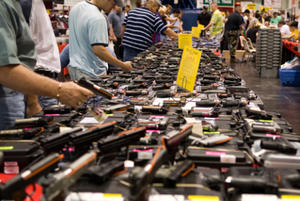Law enforcementGun dealers lost more than 62,000 guns since 2008
A recent report found that U.S. gun dealers lost more than 62,000 guns in the past three years; roughly fifty-six guns go missing each day; a gun is “lost” when it leaves a store without a background check or a formal record of sale; the number of missing guns is estimated to be significantly higher as the ATF only inspects about 20 percent of gun shops each year; these guns are highly coveted by criminals as they are virtually untraceable; each year on average, there are roughly 600 ATF inspectors who oversee the 60,000 gun shops across the United States, inspecting each shop on average once every eight years

Gun show in Houston // Source: augustow.pl
A recently published study by the Brady Center to Prevent Gun Violence found that U.S. gun dealers have lost more than 62,000 firearms in the past three years. The Brady Center advocates stricter gun laws in the United States.
Using data from the Bureau of Alcohol, Tobacco, Firearms, and explosives (ATF), the study, released last Tuesday, shows that an average of roughly fifty-six guns went missing each day. A gun is considered lost when firearms leave shops without a record of sale. These types of guns are highly coveted by criminals as they have no paperwork and cannot be traced to any individual.
In 2010 more than 21,000 guns went missing, up from 2009 which saw dealers lose 18.323 guns, but down from 2009 when dealers could not account for 22,770 guns.
Paul Helmke, president of the Brady Center to Prevent Gun Violence, criticized gun shops for what he describes as their lax inventory policies, saying, “It’s the height of irresponsibility for gun dealers to allow tens of thousands of firearms to leave their shops without background checks or a record of sale.”
He added that, “Congress is also to blame for its refusal to fully fund and staff the ATF and to strengthen our nation’s weak gun [laws].”
The Brady Center believes that the number of guns lost is significantly higher as the ATF inspects less than 20 percent of U.S. gun dealers each year.
There are roughly 600 ATF inspectors who oversee the 60,000 gun shops across the United States, inspecting each shop on average once every eight years.
Each year the agency revokes 110 licenses, while 160 gun dealers voluntarily surrender their licenses when faced with violations.
The Brady Center points to what it considers lax gun laws and improper oversight as the cause of these missing guns.
In 2001 ATF officials pushed for dealers to take an annual inventory of all their weapons, but in 2004, Congress passed the Tiahrt Amendment, proposed by Representative Todd Tiahrt (R–Kansas), which does not require gun shops to take inventories.
Helmke said, “Since the Tiahrt Amendment specifically says that ATF cannot require [inspections]it really ties their hands before they get started.”
In another Brady Center report, the center pointed to the Valley Gun shop in Baltimore, Maryland as an example of the dangerous effects of lax inventory policies.
Law enforcement officials traced more than 483 firearms used in crimes, including forty-one assaults and eleven homicides, back to the Valley Gun shop.
A 2003 inspection found more than 422 guns missing, nearly 25 percent of its entire inventory.
It took nearly ten years before ATF officials could shut the store down, despite accumulating more than 900 violations of federal gun laws.
“Every gun that leaves a gun shop without a background check is one that fuels the illegal gun market and endangers our communities,” Helmke said.
According to the Brady Center, each year on average nearly 100,000 people in America are shot or killed by a gun.
